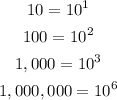In order to express this amount in scientific notation, we have to take the first digit:

Then, for the multiple of 10, we count the number of zeros as:

If we count the zeros, we have 14 zeros, so we can write:

The answer is C) 4 * 10^(14)
2) We have to divide the number of gallons of water in the Atlantic ocean (A=2*10^16) by the number of gallons in the Lake Ontario (O=4*10^14).
We can do this as:
![undefined]()